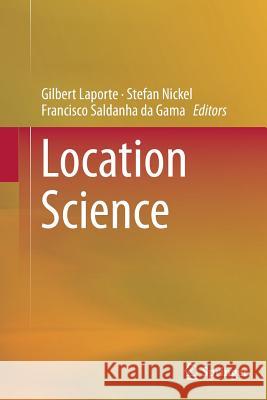Location Science » książka



Location Science
ISBN-13: 9783319342900 / Angielski / Miękka / 2016 / 644 str.
Location Science
ISBN-13: 9783319342900 / Angielski / Miękka / 2016 / 644 str.
(netto: 420,71 VAT: 5%)
Najniższa cena z 30 dni: 424,07
ok. 22 dni roboczych.
Darmowa dostawa!
This part enables the reader to understand the role of facility location in such areas, as well as to learn how to handle realistic location problems.The book is intended for researchers working on theory and applications involving location problems and models.
"This book is a collection of reviews aiming to cover much of the field of location science. ... this book aims at providing a reference point for anybody interested in location science." (Julien Ugon, Mathematical Reviews, December, 2016)
Basic Concepts.- Advanced Concepts.- Applications.
Gilbert Laporte obtained his Ph.D. in Operations Research from the London School of Economics in 1975. He is Professor of Operations Research at HEC Montréal, Canada Research Chair in Distribution Management. He has been Editor of Transportation Science, Computers & Operations Research and INFOR. He has authored or coauthored 15 books, as well as more than 450 scientific articles in combinatorial optimization, mostly in the areas of vehicle routing, location and timetabling. He has received many scientific awards including the Pergamon Prize (United Kingdom) in 1987, the 1994 Merit Award of the Canadian Operational Research Society, and the CORS Practice Prize on three occasions. He has been a member of the Royal Society of Canada since 1998, and Fellow of INFORMS since 2005. In 2009, he received the Robert M. Herman Lifetime Achievement Award in Transportation Science from the Transportation Science and Logistics Society of INFORMS. In 2014, he obtained the Lifetime Achievement in Location Analysis Award from the Section on Location Analysis of INFORMS.
Stefan Nickel obtained his Ph.D. in mathematics at the Technical University of Kaiserslautern, Germany in 1995. He is a full professor and one of the directors of the institute for Operations Research at the Karlsruhe Institute of Technology (KIT). Stefan Nickel is also member of the scientific advisory board, as well as the management board, of the Fraunhofer Institute for Applied Mathematics (ITWM) in Kaiserslautern, Germany. Since 2011 he in addition became one of the directors of the Karlsruhe Service Research Institute (KSRI) and the Research Center for Information Technology (FZI) in Karlsruhe. He has authored or co‐authored 4 books as well as around 100 scientific articles mainly in the area of location, supply chain management, health care and logistics. In addition he had numerous research contracts with well‐known companies (e.g. BASF, Lufthansa, Miele, SAP). Stefan Nickel is editor‐in‐chief of Computers & Operations Research since October 2006 and member of the editorial board of Health Care Management Science. He has coordinated the Health Care working group within the German OR society (GOR) and was the president of the GOR from 2013 to 2014. Moreover, he was coordinator of the EURO working group on locational analysis.
Francisco Saldanha da Gama is professor of Operations Research at the Department of Statistics and Operations Research at the Faculty of Science, University of Lisbon, where he received his Ph.D. in 2002. He has extensively published papers in scientific international journals mostly in the areas of location theory, supply chain management, logistics and combinatorial optimization. Together with Stefan Nickel, he has been awarded the EURO prize for the best EJOR review paper (2012) and the Elsevier prize for the EJOR top cited article 2007-2011 (2012), both with the paper entitled “Facility location and supply chain management¾A review”. He is member of various international scientific organizations such as the EURO Working Group on Location Analysis of which he is one the past coordinators. Currently, he is Area Editor of Computers & Operations Research. His research interests include stochastic mixed integer optimization, location theory and project scheduling.
This comprehensive and clearly structured book presents essential information on modern Location Science. The book is divided into three parts: basic concepts, advanced concepts and applications. Written by the most respected specialists in the field and thoroughly reviewed by the editors, it first lays out the fundamental problems in Location Science and provides the reader with basic background information on location theory. Part II covers advanced models and concepts, broadening and expanding on the content presented in Part I. It provides the reader with important tools to help them understand and solve real-world location problems. Part III is dedicated to linking Location Science with other areas like GIS, telecommunications, healthcare, rapid transit networks, districting problems and disaster events, presenting a wide range of applications. This part enables the reader to understand the role of facility location in such areas, as well as to learn how to handle realistic location problems.
The book is intended for researchers working on theory and applications involving location problems and models. It is also suitable as a textbook for graduate courses on facility location.
1997-2026 DolnySlask.com Agencja Internetowa
KrainaKsiazek.PL - Księgarnia Internetowa









